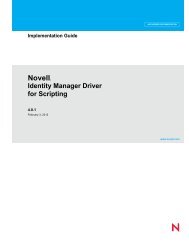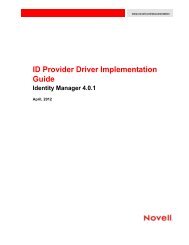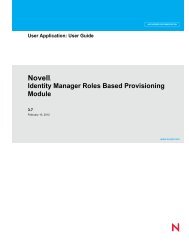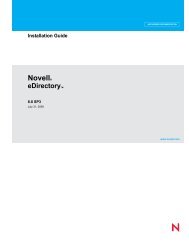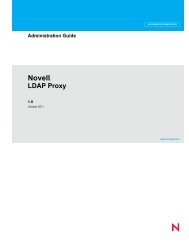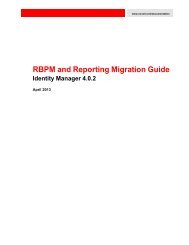Novell eDirectory 8.8 Troubleshooting Guide - NetIQ
Novell eDirectory 8.8 Troubleshooting Guide - NetIQ
Novell eDirectory 8.8 Troubleshooting Guide - NetIQ
You also want an ePaper? Increase the reach of your titles
YUMPU automatically turns print PDFs into web optimized ePapers that Google loves.
(Advanced switch option.) Deletes all objects in the local <strong>eDirectory</strong> database that have the<br />
unknown object class and maintain no subordinate objects. This option marks Unknown<br />
objects for deletion. The deletion will later be synchronized to other replicas in the <strong>eDirectory</strong><br />
tree.<br />
WARNING: Use this option only when the objects cannot be modified or deleted using<br />
ConsoleOne or iManager.<br />
novdocx (en) 22 June 2009<br />
Options on Servers Known to This Database<br />
The following repair options are available for servers:<br />
• Repair All Network Address<br />
Checks the network address for every server in the local <strong>eDirectory</strong> database. This option<br />
searches the SLP directory agent, depending on the transport protocol available, for each<br />
server’s name. Each address is then compared to the Server object’s network address property<br />
and the address record of each replica property of every partition Tree object. If the addresses<br />
are different, they are updated to be the same.<br />
• Repair Selected Server’s Network Address<br />
Checks the network address for a specific server in the local <strong>eDirectory</strong> database files. This<br />
option searches the SLP directory agent, depending on the transport protocols currently bound<br />
for the server’s name.<br />
• View Entire Server’s Name<br />
Displays the complete name of the server when the width of the server name is too great to<br />
view from within the server's table. This option is the same as the -P option. For more<br />
information, see “-P” on page 79.<br />
Examples<br />
To perform an unattended repair and log events in the /root/ndsrepair.log file, or to append events to<br />
the log file if it already exists, enter the following command:<br />
ndsrepair -U -A no -F /root/ndsrepair.log<br />
To display a list of all global schema operations along with the advanced options, enter the following<br />
command:<br />
ndsrepair -S -Ad<br />
To repair the local database by forcing a database lock, enter the following command:<br />
ndsrepair -R -l yes<br />
NOTE: The input for the ndsrepair command can be redirected from an option file. The option file<br />
is a text file that can contain replica and partition operation-related options and suboptions that do<br />
not require authentication to the server. Each option or suboption is separated by a new line. Make<br />
sure that the contents of the file are in the proper sequence. If the contents are not in the proper<br />
sequence, the results will be unpredictable.<br />
84 <strong>Novell</strong> <strong>eDirectory</strong> <strong>8.8</strong> <strong>Troubleshooting</strong> <strong>Guide</strong>




